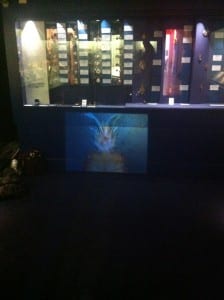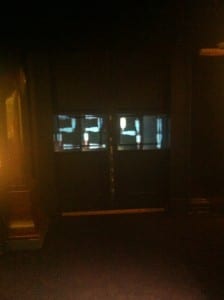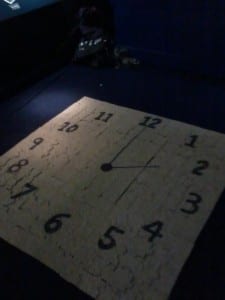Having completed our durational piece of theatre at The Usher Gallery yesterday, it can be said that our project, for the most part, was successful. Here’s a snippet of our finished product:
The movements within the secion you see above are both relatable and inspired by dance practioner Yvonne Rainer. Rainer was known for the way in which she “threw herself into a kind of anti-dance which favoured banal movements, non-expression, randomness and disconnectedness”(Roy, 2010). She focussed on the mundane movements of everyday life, much like the concepts which we experimented with throughout our piece.
As we intended, each audience member had a different experience from one another depending on what time in the day they visited Gallery 3. Our performance ran for 6 hours, after every hour slot the mechanical movement which the actors ‘performed’ would change, whilst two projections ran consistently.
These were that of a pineapple on a constant cycle of decomposition and rebirth and the countdown of a 24 hour human clock:
 Pineapple projection in Gallery 3
Pineapple projection in Gallery 3
Initially we decided to project a pineapple due to the fact that our gallery of choice already had two very quaint, porcelain pineapple dishes on show. As we developed this idea it became apparent that the fast paced decomposition of the pineapple made a beautiful contrast to that of the slower paced human clock. Although the image of the pineapple appeared somewhat distorted projected onto the back wall of the gallery, it helped to represent how our piece shows how misconstrued the nature of time itself can be when presented as an abstract concept. Looking back how effective our use of decomposition, while we felt that the image worked effectively, we still could have made much more this. If we were to create a projection similar to this again, I would like to decompose the pineapple over a longer period of time to show a clearer definition between the decomposition and the rebirth. It would also be interesting to see how the projection would have been percieved with the use of a fade opposed to that of a flash between images.
 Projection of Human Clock on the doors of Gallery 3
Projection of Human Clock on the doors of Gallery 3
The Human Clock projection was set to countdown by one minute every 15 seconds. In order to fit 24 hours into a 6 hour day, the time period which it is set in must be warped. The white clothing used in the filming of the human clock showed up incredibly well in comparison to the midnight blue door that it was being projected onto, making the image all the more powerful. With both of our projections in mind, we effectively managed to create a multi media installation; some entered the room to look directly at the images, whilst some merely stood by the door watching from a far. (See previous blog posts ‘The Pineapple Experiment’ and ‘Human Clock’ for more details on our projection concepts).
Throughout our performance, I managed to capture snippets of audience members reactions and opinions:
“You see, that’s the thing about time, you can’t always see it” – Middle aged man, whilst showing his two daughters the projection of the human clock.
“It feels like another world, it’s alien, like a matrix” – Group of audience members regarding the atmospheric ticking of a clock had created as they debated whether to enter.
“Can you guess what they’re doing?” – A mother to her son, during the mechanic movements representing the ‘dinner’ section of our piece.
The fact that the mother tried getting her child to work out what we were doing shows us that we presented a clear enough image for her to have already worked out the message that we were trying to communicate with the audience through the use of our bodies. We adopted mechanical movements to represent everyday activities that may usually go unnoticed, the repetition of the action emphasises this. We decided to include ‘eating’ sections due to the vast amount of ceremonial crockery displayed in Gallery 3. All of the objects on show were designed to be of practical use, yet are locked away without the chance of fulfilling what they were created to do. We repeated the same gesture in hope that the audience would understand that we were presenting what the objects in the galleries casing should have been used for.
In terms of the atmosphere which we created, some people embraced it and some shied away. Once we had ‘woken up’ from the first sequence of our sleeping freeze frame, it was a real pleasure to see that some members of the audience had engaged with our piece so much that they were sitting down, waiting for the next sequence to begin. This also occurred when we started to create the clock puzzle at the climactic moment of our performance. People sat and watched, engaged by the fact that they did not know how long it would take us to complete. During a two hour period in rehearsals we would repeat the piecing together of the clock puzzle twice, but with the adrenaline of a performance and a live audience we repeated this three times, due to the speed in which we were working at. During the section where we walked across the room to the beat of the clock, audience members did enter the room, but stayed much closer to the door than we would have liked in fear of getting in the way or perhaps interrupting or concentration.
In retrospect, the clock puzzle was the most powerful part of our piece, because it was the most real. Rather than performing, we were doing. If we were to experiment further with the concept touched on in our performance I would like to develop this particluar section of our piece. This would enable us to experiment with durational theatre in the traditional sense of the word. If we were to spend the 6 hours putting together a much more complex puzzle, it may have been more engaging for the audience, which would perhaps encourage the audience to interact with our performance much more than they felt comfortable doing in our previous performance.
Overall, I am happy with the experimental product which we created. If we were to perform again, I would like to create a soundscape of alarm clocks, set to go off at particular moments throughout the day, as during our performance the physical alarm clock which we were using as a prop did not go off or work as effectively as we would have hoped. Looking back at it now, I would say that we created more of an installation piece rather than a traditional ‘show’. That being said, it does not make what we presented any less of a performance. After all, can you ever really define art?
Author: Chloe Doherty
Work Cited:
– Roy, S (2010) Step-by-step guide to dance: Yvonne Rainer (Online) Available at: http://www.guardian.co.uk/stage/2010/dec/24/step-by-step-yvonne-rainer (Accessed on May 13).
